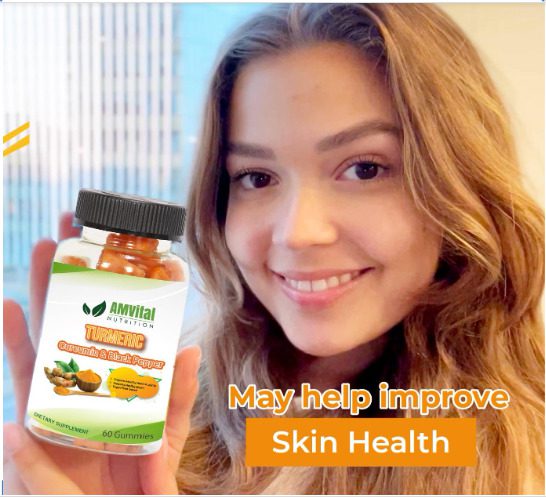Introduction
Turmeric is one of the most well-known spices in the world. It’s been used for centuries both as a spice and as a natural medicine, and it has now become famous for its many benefits. Turmeric acts as an antioxidant, anti-inflammatory agent, blood thinner (if taken with some caution), antioxidant promoter, and more. The active ingredient in turmeric is curcumin, which has been studied extensively for its health benefits but still not widely known by people who don’t use it regularly. Here are 20 ways you can use turmeric to improve your skin, hair, and overall health:
Treats Acne
Acne is a common skin condition that can be treated with turmeric. Turmeric gummies has antimicrobial properties that help treat and prevent breakouts, as well as reduce inflammation of the skin.
To use turmeric to treat acne, you can:
- Make a face mask by mixing 1 tablespoon of natural yogurt with 1 teaspoon of lemon juice and ½ teaspoon of turmeric powder. Apply the mixture to your face, let it sit for 15 minutes and then rinse off with warm water.
- Apply fresh turmeric paste to pimples or other blemishes at night before bedtime. This will help dry them out overnight by reducing swelling and redness as well as fight bacterial growth in pores caused by acne-causing bacteria like Propionibacterium acnes (P. acnes). You can also apply this paste on oily areas during the day if needed!
Helps Manage Rosacea
You can use turmeric curcumin to manage rosacea. Rosacea is a chronic and longterm skin condition that causes redness and flushing on the face. The condition is most often found in fair-skinned individuals with blue eyes and fair hair.
Turmeric, which contains curcumin, an antioxidant that has anti-inflammatory properties (and thus helps reduce redness), can help treat rosacea by reducing inflammation in your skin. You should use turmeric as part of your daily skincare routine: you can add it to your moisturizer or apply it directly to problem areas with a cotton ball after cleansing your face at night before bedtime.
Additionally, using turmeric for skin whitening is another safe way to lighten dark spots on the body such as sun damage or age spots (which are especially common on hands).
Reduces Inflammation From Eczema
Turmeric curcumin supplements can help to reduce inflammation from eczema. Inflammation is a key factor in eczema, and studies have shown that turmeric is an effective anti-inflammatory. You can use turmeric topically or take it internally to help treat the symptoms of your eczema.
Many people find that they benefit from using both methods: applying a raw turmeric paste to the affected area will provide fast relief while also allowing you to reap the benefits of its internal properties by consuming it in foods or supplements.
Fights Pigmentation
Pigmentation is a common skin problem that can be caused by acne scarring, sun damage, or simply genetics. However you got there, there are many ways to treat pigmentation using turmeric and other natural remedies.
Turmeric Face Mask
If you have a serious case of dark spots on your skin (or even just one or two), try making this simple turmeric face mask to help get rid of them naturally:
- 1/2 teaspoon of turmeric powder (make sure it’s pure; don’t use the stuff from the spice aisle)
- 2 tablespoons plain yogurt or nut butter (almond butter works best for this recipe)
- 1 tablespoon honey
Lightens Dark Circles and Improves Skin Elasticity Around the Eyes
One of the most well-known benefits of turmeric is its ability to lighten dark circles and improve skin elasticity around the eyes. This is because it’s a natural anti-inflammatory.
When applied topically, turmeric can help reduce inflammation in the dermis (the middle layer of your skin) so that more oxygen and nutrients are able to reach your outer epidermis (the top layer). This helps with wrinkles and fine lines.
Relieves Dry-Skin Symptoms
Turmeric is a great solution for dry skin, especially if you have itching or redness. Turmeric can also help with inflammation of the skin.
To use turmeric as a topical remedy for dry-skin symptoms, mix about two tablespoons of turmeric powder and one tablespoon of coconut oil together in a small bowl or mug. Add enough warm water to create a paste-like consistency that’s thick but not too thick to spread on your skin effectively.
Apply this mixture over the affected area(s) of your body, especially those areas that are cracked or itchy from dryness. Leave the curcumin-coconut oil mixture on overnight before washing off in the morning with warm water and a mild soap (such as an all-natural castile soap). If you want extra moisturizing benefits from doing this treatment regularly, add more coconut oil than called for above until you reach a desired thickness when mixing with water in step 2 above.
Works as a Natural Sunscreen (and After-Sun Skin Saver)
Turmeric is a natural SPF, so it can protect your skin from UV damage. This means that if you’re looking for a gentle alternative to conventional sunscreens that have been proven to be toxic and potentially carcinogenic, turmeric may be the solution you’ve been looking for.
Use it in place of any other natural or chemical sunscreen—you’ll get all the benefits without any of the risks!
It’s also an excellent after-sun treatment; soothing irritated skin with its anti-inflammatory properties makes this herb an ideal addition to any skincare routine.
Aids Wound Healing
Turmeric can be used to help with wound healing. It has anti-inflammatory properties that can help with skin infections and irritation.
Tames Cradle Cap in Babies
Turmeric is an effective home remedy for cradle cap. The yellow-orange spice can be massaged directly onto the scalp, or mixed with other natural ingredients to create a DIY treatment. It’s best to apply the turmeric mixture while your baby’s hair is still damp so that it absorbs into their scalp more easily.
If you want to use turmeric as a skin whitening agent, you’ll need to be patient and consistent. It can take months of regular application before you see results! However, some people have reported noticeable lightening after only three weeks of using this product on their face and body every day—so don’t give up hope just yet!
Brightens Dull Hair and Strengthens Strands
Turmeric is a natural hair lightener. If you want to brighten your dulled strands, try applying turmeric paste to your hair as a mask, or mixing it with lemon juice and olive oil for an at-home rinse. If you’re looking for something more intense, consider using turmeric as a tonic or oil—the former can help reduce dandruff and clear up scalp issues, while the latter will give your tresses an extra boost of shine.
Provides Relief for an Itchy Scalp and Dandruff
There are several different ways to use turmeric for dandruff treatment. One of the most effective methods is mixing turmeric powder with lemon juice and coconut oil. You can also create a paste by adding some castor oil or tea tree oil to your turmeric powder and blending it into a smooth paste. The mixture should be thick enough that you can apply it directly to your scalp, but not so thick that it won’t spread easily across the scalp area.
In addition to these two options, there are countless other ways to incorporate turmeric as part of your daily routine. A small pinch or two of ground tumeric powder in warm water will help relieve an irritated throat or mouth ulcer; if using this method regularly, try adding honey for extra relief from soreness!
Heals Split Ends
If you’re bothered by split ends, here’s a tip for you: turmeric.
To use turmeric for split ends, all you have to do is apply some directly to the affected area (preferably after showering) and let it sit until dry. You should notice an improvement in your hair’s quality within one or two uses!
Turmeric is really good for your skin
Turmeric is a natural anti-inflammatory, antioxidant and anti-oxidant. It’s also an anti-aging agent, as well as a skin whitener. The compound curcumin in turmeric has been shown to have anti-cancer properties, as well as antimicrobial properties (meaning it can fight off any harmful bacterial infections).
Conclusion
So, to sum up, here are the top 20 uses for turmeric. Keep in mind that these are just some of the ways you can use it on your skin and hair. The rest is up to your imagination! If there’s something else you want to know about turmeric or if there are other treatments that work well with this powerful herb, let us know in the comments section below. You can also try Turmeric curcumin supplements.



































